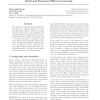106 search results - page 1 / 22 » Using relative novelty to identify useful temporal abstracti... |
ICML
2004
IEEE
16 years 1 months ago
2004
IEEE
lative Novelty to Identify Useful Temporal Abstractions in Reinforcement Learning ?Ozg?ur S?im?sek ozgur@cs.umass.edu Andrew G. Barto barto@cs.umass.edu Department of Computer Scie...
106
Voted
NIPS
2008
15 years 1 months ago
2008
In this theoretical contribution we provide mathematical proof that two of the most important classes of network learning - correlation-based differential Hebbian learning and rew...
IJCAI
2007
15 years 1 months ago
2007
We introduce an approach to autonomously creating state space abstractions for an online reinforcement learning agent using a relational representation. Our approach uses a tree-b...
ICML
2006
IEEE
16 years 1 months ago
2006
IEEE
We introduce relational temporal difference learning as an effective approach to solving multi-agent Markov decision problems with large state spaces. Our algorithm uses temporal ...
136
click to vote
COST
2009
Springer
14 years 10 months ago
2009
Springer
Synchrony is claimed by psychology as a crucial parameter of any social interaction: to give to human a feeling of natural interaction, a feeling of agency [17], an agent must be a...

